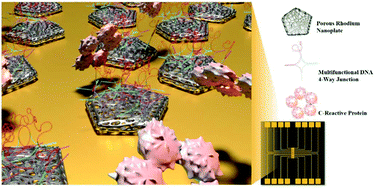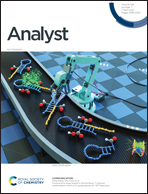Fabrication of an electrochemical biosensor composed of multi-functional Ag ion intercalated DNA four-way junctions/rhodium nanoplate heterolayer on a micro-gap for C-reactive protein detection in human serum†
Abstract
As inflammation plays a role in the pathogenesis of acute coronary syndromes, C-reactive protein (CRP) can be used as a biomarker. To detect CRP precisely, the authors prepared a CRP electrochemical biosensor consisting of an eight Ag ion-intercalated multifunctional DNA four-way junction (MF-DNA-4WJ) and a porous rhodium nanoparticle (pRhNP) heterolayer on a micro-gap electrode. To increase conductivity, we used eight Ag+ ion-inserted DNA four-way junctions through a C–C mismatch. Each DNA 4WJ was designed to have the CRP aptamer sequence, an anchoring region (thiol group), and two of four C–C mismatch regions at the end of the fragments. After an annealing step, the MF-DNA-4WJ assembly configuration and selective binding of CRP were confirmed through native TBM–PAGE (Tris-borate-magnesium chloride–polyacrylamide gel electrophoresis). The Au micro-gap electrode was fabricated to load 5 μl of the sample, and this was performed during eight experiments on one chip to establish the accuracy of the data. Then, pRhNPs were immobilized on a Au micro-gap electrode using cysteamine. To confirm the electrochemical properties, cyclic voltammetry (CV) and electrochemical impedance spectroscopy (EIS) were conducted. The durability of pRhNPs was confirmed through CV. To test the sensing performance of the prepared CRP biosensor, the limit of detection (LOD) and selectivity tests were conducted using EIS. The results indicated that charge transfer resistance (Rct) can be used efficiently to probe these interactions within the variable CRP concentration range, from 1 pM to 100 nM (0.23 ng L−1–23 μg L−1). The LOD of this sensor was 0.349 pM (0.08 ng L−1) (at S/N = 3). As a result of diluting the CRP to the same concentration range in a 20% human serum sample, the LOD was 3.55 fM (0.814 pg L−1) (at S/N = 3).

- This article is part of the themed collection: Analyst Recent HOT articles


 Please wait while we load your content...
Please wait while we load your content...